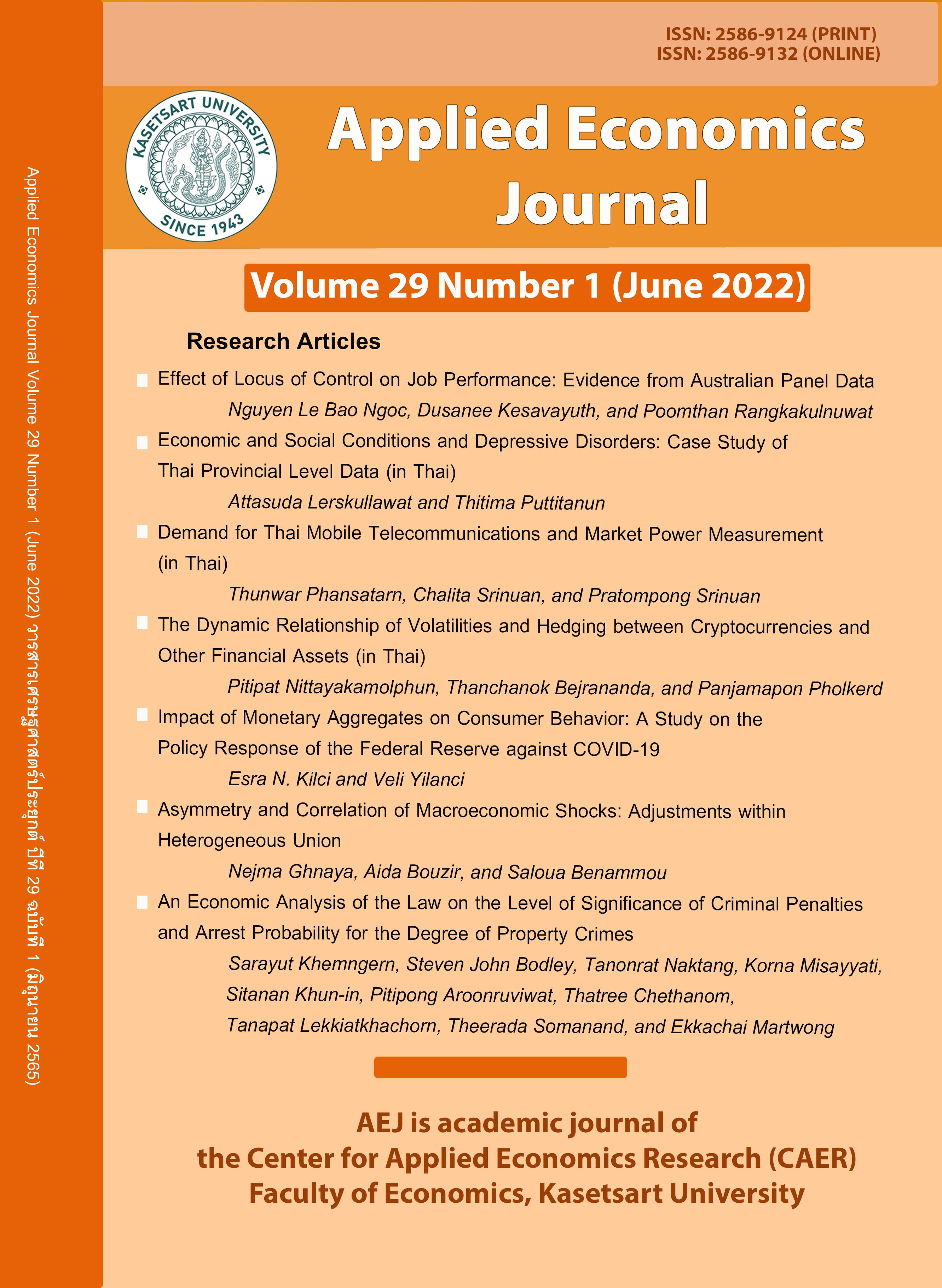Asymmetry and Correlation of Macroeconomic Shocks: Adjustments within Heterogeneous Union
Main Article Content
Abstract
This article aims to identify the asymmetry and degree of correlation of supply and demand shocks within eight European Union countries over the period 2000Q1–2020Q1. We employ a structural VAR model by decomposing macroeconomic shocks into demand and supply disturbances. We define a transformation matrix from canonical shocks to structural ones with reference to the theoretical AS-AD model by imposing a long-run restriction to verify the long-run demand shock neutrality hypothesis on production. The originality of this research paper lies in the method of shock decomposition. Our results indicating the degree of asymmetry in the European countries are relatively significant. The disparities between member countries continue to grow, and recently a form of heterogeneity has appeared that includes the degree of price flexibility and rigidity. The European Union is experiencing a dichotomy. On the one hand, core countries are correctly aligned and maintain a significantly smaller degree of asymmetry of supply and demand shocks. On the other hand, peripheral countries are characterized by flagrant inequalities that have overwhelmed their local economies. However, the various measures adopted by the European authorities remain limited. We demonstrate that to resist the potential challenges of violent fluctuations, the European authorities must move towards fiscal reforms and carefully coordinate their economic policies.
Article Details

This work is licensed under a Creative Commons Attribution-NonCommercial-NoDerivatives 4.0 International License.
The paper is published under CC BY-NC-ND, in which the article is freely downloaded and shared in its original form non-commercially and its citation details are identified.
References
Attanasio, O.P. (1999). Consumption. In J. B. Taylor & M. Woodford (Eds.), Handbook of Macroeconomics (pp. 741-812). Amsterdam: Elsevier.
Baldwin, R., & Di Mauro, B. W. (2020). Economics in the time of COVID-19: A New EBook. Retrieved from https://voxeu.org/article/economics-time-covid-19-new-ebook.
Blanchard, O. J., & Quah, D. (1989). The dynamic effects of aggregate demand and supply disturbances. American Economic Review, 79(4), 655-673.
Ben Arfa. N. (2009). Analysis of shocks affecting Europe: EMU and some Central and Eastern acceding countries. Panoeconomicus, 56(1), 21-38.
Bensaïd, J., & Gavrel, F. (1993). UEM et coordination des politiques budgétaires. Économie & prévision, 109(3), 47-56.
Burriel, P., & Galesi, A. (2018). Uncovering the heterogeneous effects of ECB unconventional monetary policies across Euro Area countries. European Economic Review, 101(C), 210-229.
Delatte, A.L., & Guillaume, A. (2020). Covid 19: a new challenge for the EMU (CEPR Working Paper No. 14848). Paris: Centre for Prospective Studies and International Information.
De Grauwe, P., & Ji, Y. (2017). Endogenous asymmetric shocks in the Eurozone: The role of animal spirits (CEPR Working Paper No.11887). London: Centre for Economic Policy Research.
Dibooglu, S., & Horvath, J. (1997). Optimum currency areas and European monetary unification. Contemporary Economic Policy, 15(1), 37-49.
Fidrmuc, J., & Korhonen, I. (2001). Similarity of supply and demand shocks between the Euro area and the CEECs (BOFIT Discussion Papers No. 14/2001). Helsinki: Bank of Finland Institute for Economies in Transition.
Frenkel, M., & Nickel, C. (2005). How symmetric are the shocks and the shocks adjustment dynamics between the euro area and central and eastern European countries? Journal of common Market Studies, 43(1), 53-74.
Georgiadis., G. (2015). Examining asymmetries in the transmission of monetary policy in the euro area: Evidence from a mixed cross-section global VAR model. European Economic Review, 75(C), 195-215.
Helg, R., Manasse, P., Monacelli, T., & Rovelli, R. (1995). How much (a) symmetry in Europe? Evidence from industrial sectors. European economic review, 39(5), 1017-1041.
Horvath, J., & Rátfai, A. (2004). Supply and demand shocks in accession countries to the Economic and Monetary Union. Journal of Comparative Economics, 32(2), 202-211.
Ingram, J.C. (1969). Comment: The currency area problem. In R. A. Mundell & A. L. Swoboda (Eds.), Monetary Problems of the International Economy (pp. 95-100). Chicago, IL: Chicago University Press.
Ingram, J.C. (1973). The case for European monetary integration. Princeton, New Jersey: International Finance Section, Princeton University Press.
Kenen, P.B. (1969). The theory of optimal currency areas: An eclectic view. Monetary Problems of the International Economy, 45 (3), 41-60.
Keynes, J. M. (1936). The general theory of employment: Interest and money [History of Economic Thought]. Retrieved from https://www.hetwebsite.net/het/home.htm
Lee, K. S., & Mercurelli, F. (2014). Convergence in the core Euro zone under the global financial crisis. Journal of Economic Integration, 29(1), 20-63.
Mélitz, J., & Weber, A. (1996). Coûts et avantages d’une politique monétaire commune en France et en Allemagne. Économie internationale, 65(1), 63-92.
Mundell, R. A. (1961). A theory of optimum currency areas. The American economic review, 51(4), 657-665.
Penot, A., Pollin, J.-P. & Seltz, V. (2000). Hétérogénéité de la zone euro et politique monétaire unique. Paper presented at the 17th GDR Symposium on Banking and Monetary Economics, 7-9 June 2000, Lisbon.
Pucar, E. B., & Glavaški, O. (2020). Macroeconomic Divergences and asymmetric responses within the Euro zone. Economics and Organization, 17(1), 27–41.
Scitovsky, T., (1976). The joyless economy: An inquiry into human satisfaction and dissatisfaction. Oxford: Oxford University Press.
Serati, M., & Venegoni, A. (2019). The cross-country impact of ECB policies: Asymmetries in – Asymmetries out? Journal of International Money and Finance Journal of International Money and Finance, 90, 118-141.
Weimann, M. (2003). OCA theory and EMU eastern enlargement – An empirical application (Working Paper series No. 8). Germany: Deutsche Bank Research.


